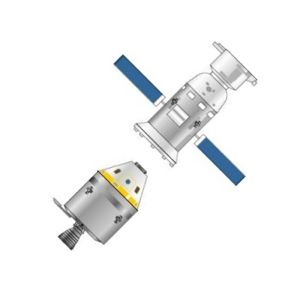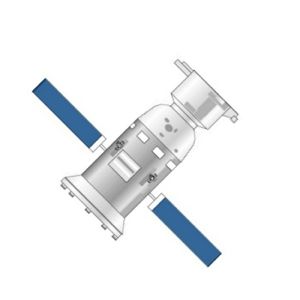
Home - Search - Browse - Alphabetic Index: 0- 1- 2- 3- 4- 5- 6- 7- 8- 9
A- B- C- D- E- F- G- H- I- J- K- L- M- N- O- P- Q- R- S- T- U- V- W- X- Y- Z
CEV Northrop
 CEV Northrop Credit: © Mark Wade |
AKA: Crew Exploration Vehicle. Status: Study 2012. Gross mass: 21,000 kg (46,000 lb). Height: 11.00 m (36.00 ft). Diameter: 5.00 m (16.40 ft).
Pictures released in late 2005 showed it to be identical to NASA's final design, an enlargement of the Apollo Command Module, using a lunar-orbit rendezvous scenario for the return to the moon.
Northrop Grumman's CEV concept up to the project's mid-term review was a much more interesting three-module Soyuz- or Shenzhou-type spacecraft. The modules were dubbed Service Module, Re-entry Module, and Habitat Module. For lunar missions, this spacecraft, with a total mass of about 21 metric tons, would rendezvous in low earth orbit with an ETS-2 space tug. A lunar lander would be separately launched and rendezvous and dock with its own ETS-2 tug.
In Northrop's original preferred scenario, both spacecraft would proceed to a space depot at the L1 Moon-Earth Lagrangian point. Here the crew would transfer to the lander, and proceed to a landing anywhere on the moon (Northrop preferred a lunar polar base). The descent stage would be left on the surface, and the ascent stage return the crew to a docking with the CEV at the L1 point. After crew transfer to the CEV, the ETS-2 would deorbit the spacecraft. The ETS-2, HM, and SM would be allowed to burn up in the atmosphere, and the RM would proceed to a parachute landing.
NASA was unhappy with the Soyuz-like spacecraft configuration, and with the L1 scenario. Northrop switched to NASA's preferred Apollo-type re-entry vehicle configuration, and adopted NASA's preferred lunar orbit rendezvous mission scenario. Now two ETS-2 stages, the CEV, and the lander would rendezvous and dock in earth orbit. The first ETS-2 stage would fire and be discarded. The second would complete the translunar injection burn. A few days later, the second ETS-2 stage would fire again to brake the combination into lunar orbit, then be discarded. The lunar module, with the HM of the CEV attached, would descend to the lunar surface. The descent stage would be left on the surface, and the ascent stage take the habitation module to lunar orbit. After docking with the CEV, the ascent stage would be discarded, and the CEV use its own power to take the crew back to the earth.
In supporting its decision to move from an L1 scenario to an LOR scenario, Northrop examined the necessary additional delta-V required to get 'anytime' back from a variety of lunar surface base locations to a CEV waiting in lunar orbit. These were as follows:
- Scenario: CEV parked at L1 Lagrangian point, lunar base anywhere on lunar surface. Delta-V from lunar orbit to L1: 677 m/s. Maximum ascent plane change delta-V required for anytime return: 0 m/s. Total delta-V: 677 m/s.
- Scenario: Scenario: CEV in equatorial lunar orbit, lunar base at lunar equator. Delta-V from lunar orbit to earth: 987 m/s. Maximum ascent plane change delta-V required for anytime return: 0 m/s. Total delta-V: 987 m/s.
- Scenario: Scenario: CEV in polar lunar orbit, lunar base at 70 deg lunar latitude. Delta-V from lunar orbit to earth: 987 m/s. Maximum ascent plane change delta-V required for anytime return: 560 m/s. Total delta-V: 1947m/s.
- Scenario: Scenario: CEV in polar lunar orbit, lunar base at 56 deg lunar latitude. Delta-V from lunar orbit to earth: 1387 m/s. Maximum ascent plane change delta-V required for anytime return: 942 m/s. Total delta-V: 2329m/s.
- Scenario: Scenario: CEV in polar lunar orbit, lunar base at 43 deg lunar latitude. Delta-V from lunar orbit to earth: 1387 m/s. Maximum ascent plane change delta-V required for anytime return: 1285 m/s. Total delta-V: 2672 m/s.
Crew Size: 4. Orbital Storage: 700 days.
Family: Lunar Bases, Manned spacecraft, Moon. Country: USA. Agency: NASA, Northrop.
 | CEV Comparison of Lockheed and Northrop CEV proposals. |
 | CEV Northrop Credit: Mark Wade |
Back to top of page
Home - Search - Browse - Alphabetic Index: 0- 1- 2- 3- 4- 5- 6- 7- 8- 9
A- B- C- D- E- F- G- H- I- J- K- L- M- N- O- P- Q- R- S- T- U- V- W- X- Y- Z
© 1997-2019 Mark Wade - Contact
© / Conditions for Use